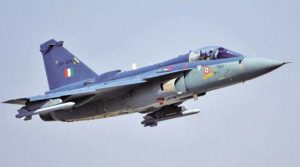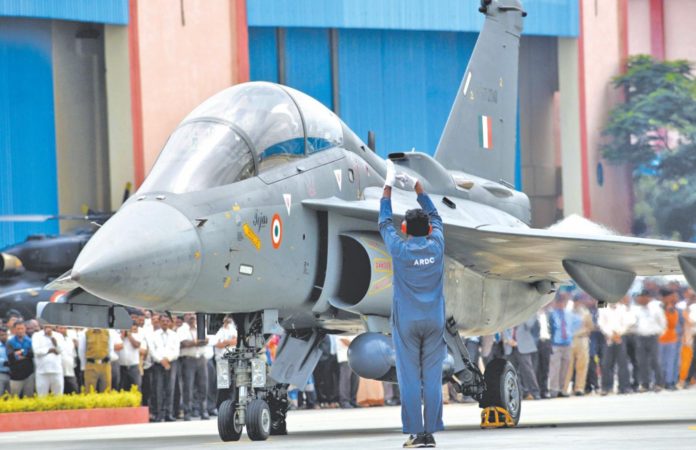The Defence Acquisition Council (DAC), on 18 March, gave the green light to the purchase of 83 Light Combat Aircraft (LCA) Mk-1A Tejas jets for approximately Rs 38,000 crore ($5.2 billion) from Hindustan Aeronautics Limited (HAL) subject to Cabinet Committee on Security approval.
Orders of 40 Tejas aircraft had been placed with HAL in initial configurations. The deal for the 83 Mk-1A jets will take the total number of Tejas variants ordered to 123. The procurement of 83 of the more advanced Mk-1A version of the aircraft would provide a significant boost to the Indian Air Force (IAF) and the Make in India initiative.
Tejas aircraft is locally designed by the Aeronautical Development Agency (ADA), a laboratory under the Defence Research and Development Organisation (DRDO), and manufactured by HAL.
The LCA Mk-1A will come with additional improvements over the final operational clearance (FOC) aircraft, making it the most advanced Tejas variant so far. It is expected to have digital radar warning receivers, external self-protection jammer pods, active electronically scanned array radar, advanced beyond-visual-range missiles and significantly improved maintainability.
HAL is expected to deliver the first Mk-1A jet to the IAF three years after the deal is signed. The first LCA Mk1A will be in the air by 2022, with series production starting a year later, a full squadron delivered by 2025 and, with sustained manufacture rate of 16 aircraft or more per year, deliveries completed by or before 2029.
The deal was earlier expected to be worth around Rs 50,000 crore but it turned out to be cheaper as the IAF reduced its requirements for spares and support facilities for the fighter jets. The price tag is at least $1.3 billion lower than the cost proposed when the IAF and HAL began sanction paperwork in 2016. Unsurprisingly, it was cost that held the deal up, with the lower unit rate helping ease the deal through.
The IAF is struggling with a shortage of warplanes. The Mk-1A jets will form the bulk of the IAF’s combat squadrons as it attempts to make up the shortfall in its fighter fleet. Compared to an optimum strength of 42-plus units required to fight a two-front war, the count of the IAF’s fighter squadrons has shrunk to 31.
In a report tabled in Parliament in December 2019, the Parliamentary standing committee on defence said “all-out steps” should be taken to ensure that the “order book position” of defence public sector units such as HAL improved in the coming years and the ministry should extend full cooperation to achieve that.
Final Operational Clearance
The Indian Air Force’s 45 Squadron ‘Flying Daggers’ began inducting LCA Tejas Mk.1 jets in 2016 in the initial operational clearance (IOC) configuration. The first FOC configured jet – SP-21 – which includes an aerial refueling probe and beyond visual range missile (BVRAAM Derby) capability, flew for the first time, on 17 March, in Bengaluru. Both capabilities have been proven since 2016.
SP-21 incorporates all the FOC configurations plus one suggested at a later stage and HAL has put efforts to make sure that from SP-21 to SP-36 all come with the same equipment (and do not have minor deviation as seen in the aircraft of first squadrons) and maintains the same production quality so that upgraded Tejas Mk1A production line will be smoother and faster.
HAL will produce 16 FOC Tejas plus eight trainers before the reverse integration of IAF’s Tejas in initial configuration is taken up.

Lifeline for HAL
The deal will prevent a complete halt of production at HAL’s facilities. HAL’s order books are empty beyond 2021-22 and new orders from the armed forces – especially for the 83 jets – are critical for continuity in production. The Mk-1A jets will also serve as a stepping stone for the Tejas Mk-2 fighters.
HAL has faced a crunch following its near completion of licenced production of the 272 Russian-origin Sukhoi Su-30MKI at its Nasik facility and the BAE Systems’ Hawk Advanced Jet Trainers (AJTs) at its Bengaluru facility. HAL badly awaits the singing of the Tejas contract and to receive the advanced payment of 15 per cent of the contract amount to replenish its depleting finances. A year ago, HAL had to borrow money from banks to pay its employees.
Tejas For Export
The government has previously informed Parliament that it was ready to offer the Tejas combat jets for exports to friendly foreign countries and has also sent the jet to air shows abroad for flying displays and static displays to potential buyers.
HAL is developing a new variant of India’s Tejas Mk1 fighter jet to cater to the export market which will be marketed as TejEx. While HAL has not revealed what will be replaced or substituted in TejEx, it is expected to come with non-Israeli and Russian weapons and systems customized as per interested countries.
TejEx will have local or substitute option for each of these sensors and weapons starting with Indo-Israeli developed MMR Radar based on ELTA’s ELM-2032 and substituting its main AAMs like I-Derby and R-73 with Astra and ASRAAM or vice a versa as per export customer requirement.
Tejas Mk 2
The Mk 2 will have double the range of its predecessor and fitted with Astra II BVR air-to-air missiles with a range of at least 150 km. While Tejas MK I is for combat air patrol within the Indian territory, MK II will have the capacity to conduct Balakot-like surgical strikes in enemy territory as it will carry heavy standoff weapons like Crystal Maze and Spice missiles.
For the Mk 2, ADA in collaboration with its parent DRDO is developing the indigenous active electronically scanned array (AESA) radar, which is not only difficult to detect but also has high resistance to jamming by the enemy during engagement.
While work on Mk 2 is proceeding apace, ADA, in consultation with IAF, will also freeze the design of its twin-engine advanced medium combat aircraft (AMCA) by July. In November 2019, the IAF gave a written commitment to DRDO that it would buy the fifth-generation AMCA to strengthen its strike capabilities.
AMCA is expected to roll out in 2024 and take to the skies the following year. The Tejas Mk 2, fitted with heavier GE 414 engine, will be a 4.5 generation aircraft. It will roll out in 2022 and take to the skies in 2023 to join IAF by 2026.
India will soon be taking up Artificial intelligence (AI) driven unmanned LCA-Tejas Concept shortly so that technology can be developed for the development of the next-generation fighter jets in the future. Development of the Unmanned LCA-Tejas for proposed wingman concept was considered to be taken up after the development of Tejas Mk1 as a low-cost option to be deployed alongside a manned aircraft to either act as a complementary asset or as a decoy to protect the crewed system from offensive air defence.
There will be two phases of the program if approved by the Government. In the first phase, network-enabled Unmanned LCA-Tejas will be developed so that it can act as a force multiplier to the manned aircraft and be used as a wing man in dangerous missions with inputs from ground controller and the crew of the manned aircraft. The second phase is more AI-driven where inputs from the human crew will be minimal and can be used.


















